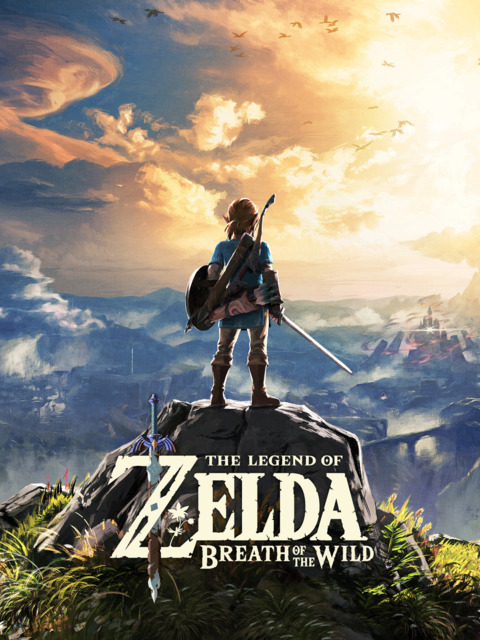Hyrule: Unmapped
Note: Before I begin, I'd like to acknowledge the fact that the version of this game that I played (Wii U) was marred by some pretty intense performance issues, mostly dealing in framerate and hitching. The reason that I am pointing this out is because 1) the technically superior version (NSW), from both my observation and (admittedly light) first-hand experience, has a product stable enough that I wouldn't even point it out in a Switch-centric review, and 2) I'm not that interested in exploring the value of this game through Nintendo's technical achievements or misgivings (even though I find technical perspectives e.g. Digital Foundry to be great and worthwhile).
So, in a way, think of this as a review of that version, even though it isn't.
---
My relationship with The Legend of Zelda is as young as it is tempestuous. The first Zelda game that I played to completion was Ocarina of Time, and that was, historically speaking, only 6 years ago (I was 16!). I have never experienced a 3D Zelda game in its own time, which I think has led to something that resembles an outsider perspective, hardened to the whimsy that people ascribe to it. When I finished OoT, it was incredibly hard to drum up the same enthusiasm that the fans have garnered for the sense of adventure and grand space that inhabits that particular version of Hyrule, and with some rare exceptions in the form of Majora's Mask's bizarre Termina & Wind Waker's adorable Great Sea, I haven't found much respite up to now. I feel its influence, but I rarely feel its magic. If anything, my need for something greater has only increased the more experienced with the Aonuma styling I've become. To date, the quest to save a 3-dimensional prospect of Hyrule has only truly captured me once, and, luckily, that less than two weeks ago in Breath of the Wild.
My experiences with 3D Zelda had prepared me for a drawling start to the game, but that sense was immediately cast away when a simple sans-serif font stating the name of the game appeared, disappeared, and left in its wake my complete control of Link. I gathered what was left for me in the shrine, and after speaking to the old man outside, was tasked with an objective that, despite its simplicity, captured the essence of what my next 90 hours would soon become.
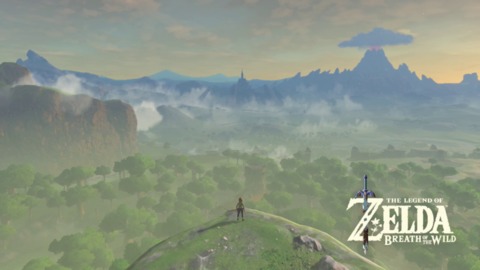
It cannot be overstated just how important this was. In my retrospective glances through the series up to now, one of my main frustrations was how the games almost never have introductory sequences that cast a positive or true light on what to expect. The most pivotal moments of any encounter are the initial ones, and while there are threads of what's to come with OoT's Kokiri Forest, and charming moments can be found in the doldrums of a personality-bolstered Zelda in Skyloft, the framing of these games never felt completely trustworthy in detailing the next X amount of hours, and, at worst, were dragged down by their adherence to tradition. By replacing the "humble township" template that has ground on both me and the average fan, it was finally able to setup some unique rules that stayed true and vibrant even by the time I entered the Hyrule Castle. In some ways, it is easier to mentally map it to the pure ethos that only Valve's linear games stick to rather than the list of open world games that players have been referencing.
Not to say that those are unfounded, obviously. Leading up to this game's release had many a critic patronizing this game's approach to open-world design, as if the memetic disposition towards "towers" in video games was something that Nintendo couldn't have been prepared to deal with. Admittedly, I was also curious to see how they managed to fit these standards into their beloved series.
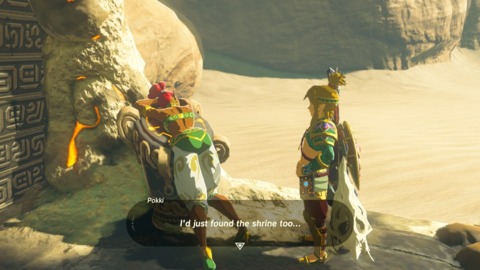
To put it simply, when you activate a tower in Breath of the Wild (which are sometimes puzzles in and of themselves), you don't uncover any points of interest, but are instead given geographic context to look for them, and are encouraged to customize and chart your own map legend. This slight curveball in the standard formula is, again, crucial to this game's success. There's a distinct difference to make in a piece of content that a game acknowledges preemptively and a piece of content "discovered" by the player. The major benefit of the latter is the feeling it provides when one is rewarded for their curiosity or adversity. Luckily for them, things like shrines are a collectible that aren't made valuable by finding them all, but finding them at all. The same goes for the Korok seeds, albeit with about 7 to 8 times the emphasis on this.
(PSA: don't try to find all the Korok seeds)
Exploration is made possible with the most drastic difference this game deals to the Zelda formula: climbing. Even with a little bit of research, I am hard-pressed to think of another 3D game that has explicitly invited this level of ground traversal. Sure, this game's contemporaries such as Skyrim, Just Cause, and Far Cry offer an equally limitless exploration, but the key difference in this game is Nintendo's commitment to it being one of, if not the most important tenant of its design. The amount of effort put into making sure that every climbable surface is accounted for had to have been colossal, and the constant streams of unique challenge and reward this mechanic provides is... unprecedented? Is that hyperbolic enough to capture the way I feel about it? Contrast this with slamming the spacebar on an incline in the Creation Engine to scale mountains, and you'll start to see why I appreciate the former for what it does.
The game isn't completely concerned with this sense of aimlessness, however; in fact, most of the authored content lies in specific areas such as villages and stables. The quality of these paths range from my favorite in the series to slightly below average. At the peak is something like Rito Village, with an interesting vertical layout that culminates into a brilliantly designed dungeon (which, even though this is a spoiler-friendly review, I don't even want to speak on for fear that someone wouldn't be able to play them blindly). At the lowest point is something like the Yiga Clan Hideout, which bends the preconceived rules of this game for some cheaply gained novelty in a pretty obnoxious and rote stealth segment. For some, these segments are going to be the bulk of what they play, and for others, they'll merely be the checkpoints in between the bulk. As a person who identifies with the latter, I don't know if I'd be as enthusiastic about the game if I only experienced the critical path, even if I did enjoy it on the whole.
In between these major moments lie side quests that are reminiscent of your average open-world or RPG (or Zelda, even). While some are genuinely entertaining, a disappointing amount of them are either simple fetch quests with little else to them or missions that end in humorously unbalanced rewards for their completion (e.g. "Thanks for the 20 rupees," I say with end-game items overflowing my inventory). Even at their best, these parts are the ones that stick closest to the previous formula, and by sheer comparison to the rest of the game, hold some inherent disinterest. One of the latent drawbacks to this game's focus is how adorning its core with the fanciful Zeldaisms of old becomes increasingly harder to do, even if they hold individual charm. This game is at its most impressive when it isn't being very "Zelda".
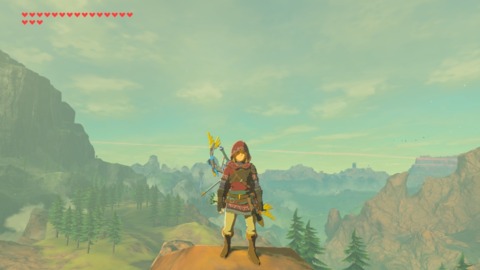
The major point this game makes in its series' context is how unafraid it is to push beyond the now-standardized flow of Zelda. I'm sure there are additions to this game that ruffle the feathers of long-time fans, and as a loyal fan to other series', I can sympathize. Although I found the execution of it to be consistently bold and exciting, the weapon degradation system's tempo is one that even some survival-focused games don't dare to keep up with. You'll have to scavenge for new weapons that may or may not be better than your recently destroyed ones, and the line graph of "weapon quality over time" has more plateaus and valleys than expected. In my experience, I never really found there to be any moments where I felt overwhelmingly screwed out of an optimal loadout, but there were moments of opening treasure chests only to find less useful items than what I was carrying, and that never felt great. Advice to newcomers: use your stuff, and don't be afraid to pick up an enemy's weapon if only to beat them.
Even with all these things in mind, one of the most interesting and symbolic changes that Nintendo has made for Breath of the Wild is the introduction of... a rather amorphous concept. Some people describe it as "systems" and use phrases like "emergent gameplay" when referring to it, but I think it's best laid out for the layman as "details and mechanics that customize and ground your experience." As a single example, there was a puzzle I was doing that involved using the Sheikah Slate's Magnesis ability to swing metal pendulums. The obvious route through the puzzle is to use gravity to make them swing, and run through like you would in any game that had these traps. However, because the game's physics system (Zelda has a physics system now, by the way) is as accommodating as it is, a legitimate solution was to wrap the pendulum's chain around its base like a noodle around a fork, trivializing the entire process, and allowing Link to waltz through. When I did this, I laughed. This game is confident enough to allow you to just ignore it sometimes. It doesn't feel the need to pester you with its own vision, and in fact, values your input in ways that most games don't.
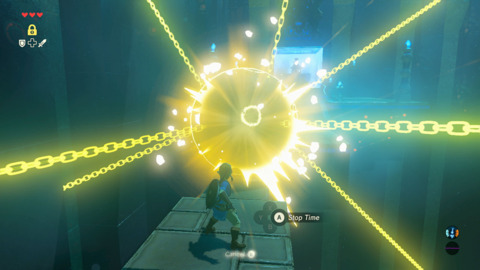
Each of the Slate's abilities provide some level of encouragement to use them as if they were part of your standard repertoire. Metal boxes and barrels adorn enemy bases as if to say, "Hey, you know what would hurt this Moblin's head?" Long bodies of water separate you and whatever it is you're after, and Cryonis is happy to help you so long as you have some dedication and a little wit. Perhaps the most unassuming one is Stasis, which simply lets you freeze things and manipulate their trajectory before they resume being normal objects. It seems basic at first, and maybe even a bit pointless, but once you start to get creative, it ends up becoming the most valuable entry into the set. It alone helped me finish a puzzle in a way that I can confidently say was completely unintentional. I won't go into details, but I might have gotten a special item much sooner than they intended. Perhaps they did intend it, though, and that's the exciting part.
Just to remind you, this is The Legend of Zelda. This isn't Far Cry 2 or Mercenaries. There are no grizzled warmongers to be found. Nintendo made complexity cute, and that's kind of astonishing.
---
Listen, there's a lot that I didn't cover. Food, horses, Beedle, etc.. I could talk about how I love the option to disable most of the HUD, or how the story made me feel; frankly speaking, if I wanted this giant review to extend even further, I could easily do so, but I'm already pushing anyone's interest. That being said, I think my thoughts can be summarized pretty simply: Breath of the Wild is proof that 99% of modern game design grew from the soil that Nintendo first planted in. If anything, 1986's The Legend of Zelda stands as a 31-year-old reminder that, however docile it might have been, embedded into the DNA of their company was a sucker punch that would leave its imprint onto the face of the industry, simply stating:
"Dear everyone else,
We got this.
Sincerely,
Nintendo"
